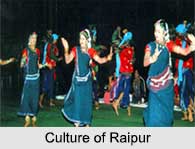 Raipur is the capital city of Chhattisgarh and the administrative headquarters of Raipur District. It was previously a part of Madhya Pradesh before the state of Chhattisgarh was formed on November 1, 2000. It is sometimes referred as the "Rice Bowl of India" as varieties of rice are grown here.
Raipur is the capital city of Chhattisgarh and the administrative headquarters of Raipur District. It was previously a part of Madhya Pradesh before the state of Chhattisgarh was formed on November 1, 2000. It is sometimes referred as the "Rice Bowl of India" as varieties of rice are grown here.
History of Raipur
Raipur was once a part of the "Dakshina Kosala Kingdom". Later it became a part of the Maurya Empire. In the 4th century CE, Gupta king Samudragupta defeated this area and established Gupta control in the region. For some time in the 5th and 6th centuries, Nala kings ruled this region. Later on Somavanshi kings took rule and controlled with Sirpur. Mahashivgupta Balarjun was the emperor of this dynasty.
The "Kalachuri" dynasty of Tumman ruled Raipur for a long period and made Ratanpur their capital. It was the capital of a branch of the Kalachuri dynasty and is believed that King Ramachandra established the city of Raipur. Another tale about Raipur is that King Ramachandra`s son Brahmdeo Rai had established Raipur, where Raipur means King`s City, from Sankrit Rai. His capital was "Khalwatika" (now Khallari). With the death of Raghuji III, the area was assumed by the British government from Bhonsla`a of Nagpur and Chhattisgarh was declared a separate division. At the time of the independence of India, Raipur district was incorporated in the Central Provinces and Berar.
 Geography of Raipur
Geography of Raipur
Raipur is located near the centre of a large plain and Mahanadi River flows to the east of the city of Raipur, and the southern side has intense forests. Maikal Hills rise on the north-west of Raipur and on the north; the land rises and unites with the Chota Nagpur Plateau, which extends north-east across Jharkhand state. On the south of Raipur lies the Deccan Plateau.
Climate of Raipur
 Raipur has a steamy wet and dried up climate. The temperature in April–May sometimes rises above 48 degree centigrade. In summers, the temperature can also go up to 50 degree centigrade. The city receives about 1,300 millimetres (51 in) of rain, mostly in the monsoon season from late June to early October.
Raipur has a steamy wet and dried up climate. The temperature in April–May sometimes rises above 48 degree centigrade. In summers, the temperature can also go up to 50 degree centigrade. The city receives about 1,300 millimetres (51 in) of rain, mostly in the monsoon season from late June to early October.
Culture of Raipur
The festivals celebrated in Raipur include "Hareli", "Dussehra", "Teeja and Pola" along with "Champaran Mela". The relics of the tribal people here signify their legends and nature like Bamboo articles, metal artefacts, tribal painting and stone carving. The Chhattisgarhi food includes food preparations from rice and rice flour and lentils, making their food rich and nourishing. "Mahua" is an important factor in the tribal food, which is delectable to taste and the sweet of "jalebi" is a favourite among all the locals.
Demography of Raipur
As of the 2011 census, Raipur Municipal Corporation had a population of 1,010,087, of which 519,286 are males and 490,801 are females with a sex ratio of 945 females per 1000 males, higher than the national standard of 940 per 1000.
Education of Raipur
It is the only city in India which is home to Indian Institutes of Management, National Institutes of Technology, All India Institutes of Medical Sciences, Hidayatullah National Law University, and Indian Institutes of Information Technology. Some of the popular educational institutes of Raipur:
•Indian Institute of Management (IIM) Raipur
•National Institute of Technology (NIT) Raipur
•All India Institute of Medical Sciences (AIIMS) Raipur
•Hidayatullah National Law University (HNLU) Raipur
•International Institute of Information Technology, Naya Raipur
•Pandit Ravishankar Shukla University
•Indira Gandhi Agricultural University
•Kushabhau Thakre Patrakarita Avam Jansanchar University
•Ayush & Health Sciences University Chhattisgarh
•Chhattisgarh Kamdhenu Vishwavidyalaya
•New Government Engineering College
•Government Ayurvedic Medical College
•Government Dental College
•Government Homeopathic College
•Central college of Engineering and Management
•Shri Shankaracharya Institute of Professional Management and Technology
 Media of Raipur
Media of Raipur
Many national and local newspapers are published from Raipur both in Hindi and English like Dainik Bhaskar, Nava Bharat, The Times of India, Hindustan Times, Deshbandhu etc. Raipur has 6 FM Radio Stations namely 94.3 FM My FM, 95.0 FM FM Tadka, 98.3 FM Radio Mirchi, 101.6 FM All India Radio Bilaspur and Vividh Bharti and 104.8 FM Radio Rangila.
Economy of Raipur
Raipur was the second major commercial centre in Madhya Pradesh after Indore. Raipur`s financial system has been based on agricultural-processing, Steel, Cement, Alloy, Poha and Rice. It is becoming a significant local commercial and industrial end for the coal, power, plywood, steel and aluminium industries.
Attractions of Raipur
Kevalya Dham is Jain temple of white marble which is one of the foremost tourist attractions. The temple is also famous as "Sri Adinath Jain Shwetambar Tirth" collection of 26 small and big Jain temples wonderfully built with marbles. Other attractions include Mahant Ghasidas Museum, Guru Tegh Bahadur Museum, Kanha National Park, Achanakmar Wildlife Sanctuary, Amarkantak, Bhoramdeo Temple and so on.
Visiting Information of Raipur
There are regular trains from other major cities of the country to Raipur. Raipur is well connected to other major cities of the country via regular buses. People can simply get normal flights to Raipur from other foremost cities of the country.
Naya Raipur is the new capital of Chhattisgarh.



















